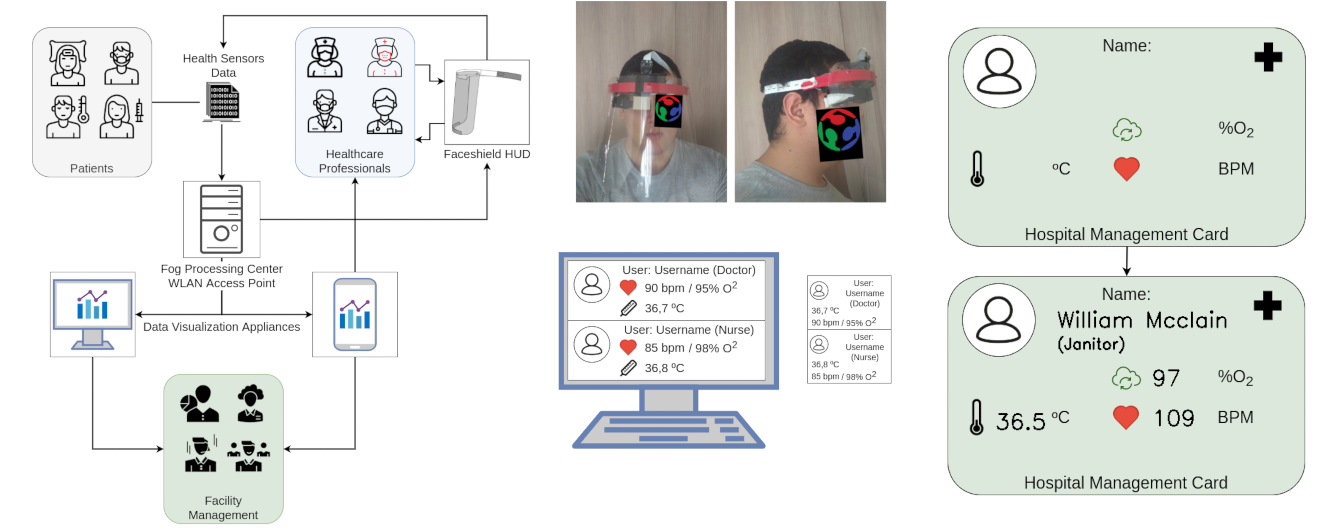Edge Computing Smart Healthcare Cooperative Architecture for COVID-19 Medical Facilities
Keywords:
smart healthcare, cooperative systems, edge computing, IoTAbstract
Intelligent healthcare systems are a topic of interest in recent approaches due to novel possibilities created from edge hardware and software development. In 2020, the COVID-19 pandemic displayed the urge to speed up technological systems development to aid medical facilities. In this context, solutions must enhance the experience of both patients and healthcare professionals. Thus, we propose a novel cooperative architecture to improve healthcare facilities involved in pandemic control. On the one hand, this solution helps a faster recognition and link to the patients' data using reality augmentation resources. On the other hand, it helps monitor the conditions of medical professionals working in the facility and exposed to contamination danger.
Downloads
References
V. Vippalapalli and S. Ananthula, “Internet of things (iot) based
smart health care system,” in 2016 International Conference on Signal
Processing, Communication, Power and Embedded System (SCOPES),
pp. 1229–1233, IEEE, 2016.
S. Sivagami, D. Revathy, and L. Nithyabharathi, “Smart health care
system implemented using iot,” International Journal of Contemporary
Research in Computer Science and Technology, vol. 2, no. 3, pp. 641–
, 2016.
M. Alhussein and G. Muhammad, “Automatic voice pathology moni-
toring using parallel deep models for smart healthcare,” IEEE Access,
vol. 7, pp. 46474–46479, 2019.
Z. Chen, S. He, F. Li, J. Yin, and X. Chen, “Mobile field hospitals, an
effective way of dealing with covid-19 in china: sharing our experience,”
BioScience Trends, 2020.
A. S. Kliger and J. Silberzweig, “Mitigating risk of covid-19 in dialysis
facilities,” Clinical Journal of the American Society of Nephrology,
vol. 15, no. 5, pp. 707–709, 2020.
J. Wong, Q. Y. Goh, Z. Tan, S. A. Lie, Y. C. Tay, S. Y. Ng, and C. R.
Soh, “Preparing for a covid-19 pandemic: a review of operating room
outbreak response measures in a large tertiary hospital in singapore,”
Canadian Journal of Anesthesia/Journal canadien d’anesthésie, pp. 1–
, 2020.
V. N. Prachand, R. Milner, P. Angelos, M. C. Posner, J. J. Fung,
N. Agrawal, V. Jeevanandam, and J. B. Matthews, “Medically-necessary,
time-sensitive procedures: A scoring system to ethically and efficiently
manage resource scarcity and provider risk during the covid-19 pan-
demic,” Journal of the American College of Surgeons, 2020.
S. Shah, K. Majmudar, A. Stein, N. Gupta, S. Suppes, M. Karamanis,
J. Capannari, S. Sethi, and C. Patte, “Novel use of home pulse oximetry
monitoring in covid-19 patients discharged from the emergency depart-
ment identifies need for hospitalization,” Academic Emergency Medicine,
vol. n/a, no. n/a.
S. B. Baker, W. Xiang, and I. Atkinson, “Internet of things for smart
healthcare: Technologies, challenges, and opportunities,” IEEE Access,
vol. 5, pp. 26521–26544, 2017.
A. Rizwan, A. Zoha, R. Zhang, W. Ahmad, K. Arshad, N. A. Ali,
A. Alomainy, M. A. Imran, and Q. H. Abbasi, “A review on the role of
nano-communication in future healthcare systems: A big data analytics
perspective,” IEEE Access, vol. 6, pp. 41903–41920, 2018.
G. Manogaran, R. Varatharajan, D. Lopez, P. M. Kumar, R. Sun-
darasekar, and C. Thota, “A new architecture of internet of things and
big data ecosystem for secured smart healthcare monitoring and alerting
system,” Future Generation Computer Systems, vol. 82, pp. 375–387,
M. S. Hossain, G. Muhammad, and A. Alamri, “Smart healthcare
monitoring: A voice pathology detection paradigm for smart cities,”
Multimedia Systems, vol. 25, no. 5, pp. 565–575, 2019.
M. A. Salahuddin, A. Al-Fuqaha, M. Guizani, K. Shuaib, and F. Sallabi,
“Softwarization of internet of things infrastructure for secure and smart
healthcare,” arXiv preprint arXiv:1805.11011, 2018.
S. Tuli, N. Basumatary, S. S. Gill, M. Kahani, R. C. Arya, G. S. Wander,
and R. Buyya, “Healthfog: An ensemble deep learning based smart
healthcare system for automatic diagnosis of heart diseases in integrated
iot and fog computing environments,” Future Generation Computer
Systems, vol. 104, pp. 187–200, 2020.
M. C. Silva, V. J. Amorim, S. P. Ribeiro, and R. A. Oliveira, “Field
research cooperative wearable systems: Challenges in requirements,
design and validation,” Sensors, vol. 19, no. 20, p. 4417, 2019.
C. Long, Y. Cao, T. Jiang, and Q. Zhang, “Edge computing framework
for cooperative video processing in multimedia iot systems,” IEEE
Transactions on Multimedia, vol. 20, no. 5, pp. 1126–1139, 2017.
M. S. Mahmoud and A. A. Mohamad, “A study of efficient power
consumption wireless communication techniques/modules for internet
of things (iot) applications,” 2016.
C. Chang, S. N. Srirama, and R. Buyya, “Indie fog: An efficient fog-
computing infrastructure for the internet of things,” Computer, vol. 50,
no. 9, pp. 92–98, 2017.
M. Silva., R. Oliveira., T. D’Angelo., C. Garrocho., and V. Amorim.,
“Faceshield hud: Extended usage of wearable computing on the covid-
frontline,” in Proceedings of the 23rd International Conference
on Enterprise Information Systems - Volume 1: ICEIS,, pp. 893–900,
INSTICC, SciTePress, 2021.
S. Majumder, T. Mondal, and M. J. Deen, “Wearable sensors for remote
health monitoring,” Sensors, vol. 17, no. 1, p. 130, 2017.
K. Cao, G. Xu, J. Zhou, T. Wei, M. Chen, and S. Hu, “Qos-adaptive
approximate real-time computation for mobility-aware iot lifetime opti-
mization,” IEEE Transactions on Computer-Aided Design of Integrated
Circuits and Systems, vol. 38, no. 10, pp. 1799–1810, 2018.
M. Silva and R. Oliveira, “Analyzing the effect of increased distribution
on a wearable appliance,” in 2019 IEEE 43rd Annual Computer Software
and Applications Conference (COMPSAC), vol. 2, pp. 13–18, IEEE,


